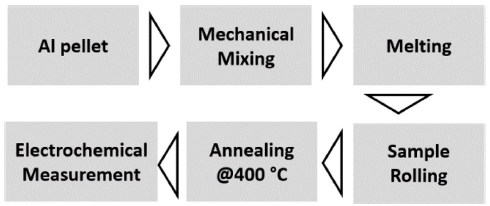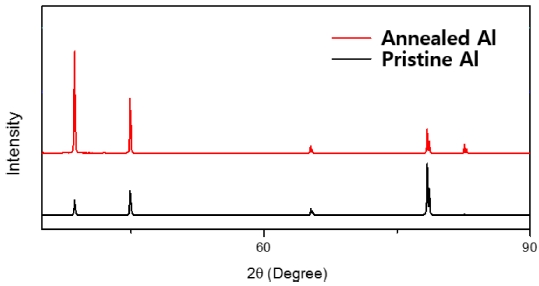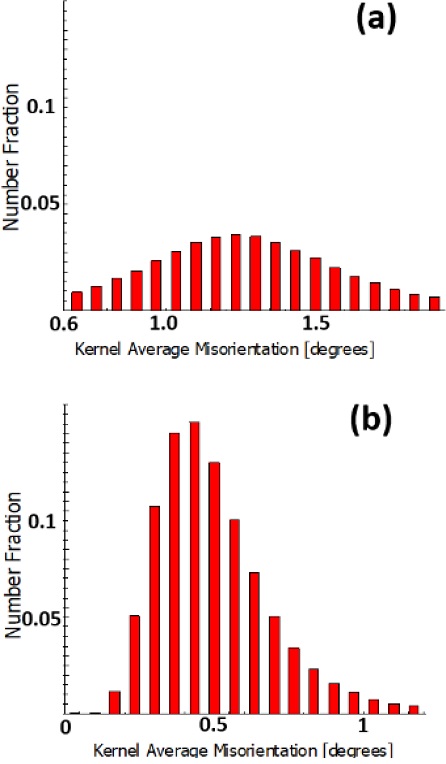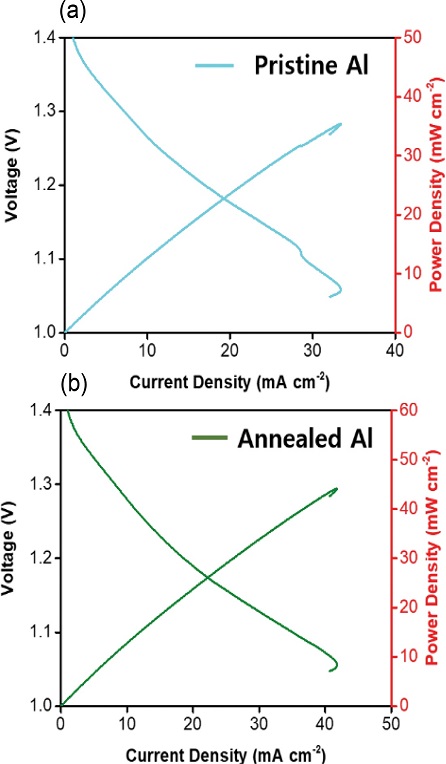
금속 공기 전지의 열처리에 따른 성능 변화 해석
Copyright © The Korean Society for Precision Engineering
This is an Open-Access article distributed under the terms of the Creative Commons Attribution Non-Commercial License (http://creativecommons.org/licenses/by-nc/3.0) which permits unrestricted non-commercial use, distribution, and reproduction in any medium, provided the original work is properly cited.
Abstract
The objective of this study was to investigate the effect of heat treatment on electrochemical performance of aluminum (Al)-air battery. We prepared a pure Al and an annealed Al under an annealing environment [a mixture gas of Ar (97%) and H2 (3%)] of 400°C for 1 hr. Based on electron backscatter diffraction analysis of Al at the anode, the relative misorientation of the pristine Al was higher than that of the annealed Al. Electrochemical performances of the pristine Al-air and the annealed Al-air were also compared. The annealed Al-air battery showed slightly higher power density than the pristine Al-air battery. These results suggest that annealing with heat treatment is an important process to improve the electrochemical performance of aluminum-air battery.
Keywords:
Metal-air battery, Deformation, Heat treatment, Voltage-current, Metal oxidation키워드:
금속공기전지, 소성, 열처리, 전압-전류, 금속산화1. 서론
일반적으로 금속-공기 전지(Metal-Air Battery)는 금속을 사용하는 음극(Anode)에서는 산화가 백금-카본(Pt-C)을 사용하며 양극(Cathode)에서 환원반응이 일어난다(Fig. 1).1 금속-공기전지는 리튬-공기(Li-Air),2,3 철-공기(Fe-Air),4,5 마그네슘-공기(Mg-Air),6,7 실리콘-공기(Si-Air),8,9 알루미늄-공기(Al-Air),10,11 아연-공기(Zn-Air)2,12 등이 일반적이며 금속의 특성에 따라 에너지 밀도, 전압이 달라진다. 최근에 전기차에 적용하기 위해서 금속-공기 전지에 대한 연구를 많이 진행이 되었으며 내구성에 직접적인 영향을 주는 충방전(Charge/Discharge) 특성을 개선시키기 위한 연구가 많이 진행이 되었다.13 일반적으로 양극에서는 전류 및 전압 성능을 높이기 위해서 산소 환원반응의 속도를 높이기 위한 금속 및 지지체에 대한 연구를 많이 하고 있다.14,15 특히 충전 특성은 음극에 크게 영향을 받게 되는데 방전 시에 금속화합물이 다시 충전 시에 원래 음극으로 돌아갈 때 특정한 반응성이 우수한 지점으로만 돌아가거나 혹은 덴드라이트(Dendrite) 모양으로 금속이 성장하여 쇼트를 발생시키거나 전체 반응성을 떨어뜨리게 하는 현상을 발생시킨다.13 최근에 알루미늄-공기 전지의 전해질을 순환시켜서 전해질내의 덴드라이트 생성을 억제시키는 연구가 보고 되었다.14 또한 충방전 특성을 개선시키기 위해서 갈륨, 마그네슘, 아연, 주석과 같은 금속을 음극에 첨가하는 연구가 진행이 되었다.15 특히 알루미늄은 자기부식(Self-Corrosion)이 매우 빨라서 아연을 첨가하여 자기부식을 줄이는 억제하는 금속으로 적합하다. 이것은 패시베이션층(Passivation Layer)을 형성하여 자기부식을 줄이는 방법이나 고출력을 요구하는 상황에서는 이 패시베이션층이 성능을 떨어드리는 역할을 하게 하는 문제가 발생한다.16-18 그래서 알루미늄-아연에 인듐과 같은 금속을 첨가하는 연구도 진행이 되었다. 그러나 금속의 내부 구조(결정, 전위, 결정립)에 따른 전기화학적 성능에 대한 연구는 매우 부족하다.
본 연구에서는 금속-공기 전지의 음극소재인 알루미늄을 사용하여 기계적인 열처리를 통해서 배터리의 전기적인 특성이 어떻게 변화하는지 관찰하고 전위(Dislocation)이 성능에 어떠한 영향을 미치는지 확인해보고자 하였다.
2. 실험 방법
알루미늄(99.9%) 펠렛(#00632, Alfa Aesar)을 기계적으로 고르게 부순 다음 측정을 위한 크기로 만들기 위해서 Fig. 2에서 보듯 첫번째로 고온 750도 전기로에서 아르곤 및 수소 혼합 가스 분위기(99.999%)에서 녹인 다음 샘플에 소성 변형을 만들기 위해서 롤링을 통해서 샘플을 제작한다. 여기서 소성 변형은 30%이다. 지름은 약 15 mm 크기 원형 샘플을 제작한다. 전기화학적 성능 측정은 코인셀 타입으로 조립하였으며 음극은 제작된 금속 샘플, 전해질은 유리섬유 분리막(EL-CELL, ECC1-01-0012), 공기극은 Pt/C+IrO2를 사용하였다. 이때 Pt/C와 IrO2의 비율은 1:1이다. 전해질에는 5몰 KOH용액을 분리막에 충분히 적셔주었다. 전기화학측정은 개회로전압에서 0 V까지 10mV/sec의 속도로 Potentiodynamic으로 변화시켜가면 전류를 측정하였다. 제작된 샘플은 결정성 분석을 위해서 분석을 위해서 30도에서 90도까지 X-ray Diffraction (XRD, PAN Analytical X’pert) 분석을 하였다. Electron Backscatter Diffraction (EBSD, DigiView Detector, SU-10, Hitachi)를 통해 샘플의 내부 구조분석을 수행하였다.
3. 결과 및 토의
Fig. 3은 열처리 전후에 따라 알루미늄 샘플의 결정성 분석 결과이다. FWHM (Full Width at Half Maximum)값을 비교 결과 400도 열처리한 샘플의 경우에 초기상태보다 전반적인 결정성이 개선됨을 확인할 수 있다.
Fig. 4는 EBSD를 통하여 각 샘플의 Kernel Average Misorientation량을 상대적으로 측정하였다. 본 분석을 통해 금속 내부에 전위(Dislocation)의 양을 알 수 있는데 Fig. 4(a)는 열처리를 하지 않은 샘플의 결과를 보여주는데 X축 값인 Kernel Average Misorientation이 1.0에서 1.5사이에서 최대구간임을 알 수 있는데 반면 열처리를 한 샘플인 Fig. 4(b)는 0.5 미만에서 최대값을 보여주고 있다. 두 샘플 분석 결과에서 열처리를 한 경우 금속 내부의 전위가 대폭 줄어들었음을 보여주고 있다. 일반적으로 롤링 공정을 거치면 전위 증가로 인하여 내부 응력이 증가하는데 열처리 공정으로 인하여 내부 응력은 증가하고 내부 결정은 개선되었음을 확인할 수 있다.
Fig. 4는 열처리 전후에 따라 전기화학적 성능이 어떻게 변화하는지에 대한 실험을 하였다. Fig. 5(a)는 초기 알루미늄-공기 전지 샘플이며 Fig. 5(b)는 열처리한 알루니늄-공기 전지 샘플의 전압-전류-전력밀도 그래프이다. 그 결과 열처리한 샘플이 상대적으로 높은 성능이 측정됨을 확인하였다. 일반적으로 알루미늄-공기전지는 자기 부식이 매우 빨라서 고전류 영역의 성능을 측정하기가 어려운데 그럼에도 불구하고 최대 출력밀도는 열처리한 샘플(b)에서 약 45 mW/cm2, 열처리 하지 않은 알루미늄 샘플(a)에서 약 36 mW/cm2으로 측정되었다.
4. 결론
본 연구에서는 알루미늄-공기 전지에서 금속의 열처리를 통하여 금속 내부 전위를 감소시킴에 따라 알루미늄-공기 전지의 전기화학적 성능이 개선됨을 확인하였다. 이것은 내부 전위량 감소가 전기화학적 성능에 영향을 준다는 것을 금속 공기 전지에서 처음으로 확인하였다. 향후 금속 내부의 정량적인 전위량과 금속공기 전지의 전지화학적 특성 사이에 정량적인 연관 관계에 대한 추가적인 연구를 수행 할 예정이다.
Acknowledgments
이 성과는 2017년도 정부(과학기술정보통신부)의 재원으로 한국연구재단의 지원을 받아 수행된 연구임(2017R1C1B5018183).
REFERENCES
-
Li, Y. and Dai, H., “Recent Advances in Zinc–Air Batteries,” Chemical Society Reviews, Vol. 43, No. 15, pp. 5257-5275, 2014.
[https://doi.org/10.1039/C4CS00015C]

-
Balaish, M., Kraytsberg, A., and Ein-Eli, Y., “A Critical Review on Lithium–Air Battery Electrolytes,” Physical Chemistry Chemical Physics, Vol. 16, No. 7, pp. 2801-2822, 2014.
[https://doi.org/10.1039/c3cp54165g]

-
Grande, L., Paillard, E., Hassoun, J., Park, J. B., Lee, Y. J., et al., “The Lithium/Air Battery: Still an Emerging System or a Practical Reality?” Advanced materials, Vol. 27, No. 5, pp. 784-800, 2015.
[https://doi.org/10.1002/adma.201403064]

-
Inoishi, A., Hyodo, J., Kim, H., Sakai, T., Ida, S., et al., “Low Temperature Operation of a Solid-Oxide Fe–Air Rechargeable Battery Using a La0.9Sr0.1Ga0.8Mg0.2O3 Oxide Ion Conductor,” Journal of Materials Chemistry A, Vol. 3, No. 16, pp. 8260-8264, 2015.
[https://doi.org/10.1039/C4TA06780K]

-
Hang, B. T., Yoon, S.-H., Okada, S., and Yamaki, J., “Effect of Metal-Sulfide Additives on Electrochemical Properties of Nano-Sized Fe2O3-Loaded carbon for Fe/Air Battery Anodes,” Journal of Power Sources, Vol. 168, No. 2, pp. 522-532, 2007.
[https://doi.org/10.1016/j.jpowsour.2007.02.067]

-
Cheng, C., Li, S., Xia, Y., Ma, L., Nie, C., et al., “Atomic Fe–Nx Coupled Open-Mesoporous Carbon Nanofibers for Efficient and Bioadaptable Oxygen Electrode in Mg–Air Batteries,” Advanced Materials, Vol. 30, No. 40, pp. 1802669, 2018.
[https://doi.org/10.1002/adma.201802669]

-
Li, W., Li, C., Zhou, C., Ma, H., and Chen, J., “Metallic Magnesium Nano/Mesoscale Structures: Their Shape Controlled Preparation and Mg/Air Battery Applications,” Angewandte Chemie International Edition, Vol. 45, No. 36, pp. 6009-6012, 2006.
[https://doi.org/10.1002/anie.200600099]

-
Zhong, X., Zhang, H., Liu, Y., Bai, J., Liao, L., et al., “High Capacity Silicon–Air Battery in Alkaline Solution,” ChemSusChem, Vol. 5, No. 1, pp. 177-180, 2012.
[https://doi.org/10.1002/cssc.201100426]

-
Park, M.-H., Kim, M. G., Joo, J., Kim, K., Kim, J., et al., “Silicon Nanotube Battery Anodes,” Nano Letters, Vol. 9, No. 11, pp. 3844-3847, 2009.
[https://doi.org/10.1021/nl902058c]

-
Gelman, D., Shvartsev, B., and Ein-Eli, Y., “Aluminum–Air Battery Based on an Ionic Liquid Electrolyte,” Journal of Materials Chemistry A, Vol. 2, No. 47, pp. 20237-20242, 2014.
[https://doi.org/10.1039/C4TA04721D]

-
Lee, J. S., Tai Kim, S., Cao, R., Choi, N. S., Liu, M., et al., “Metal–Air Batteries with High Energy Density: Li–Air Versus Zn–Air,” Advanced Energy Materials, Vol. 1, No. 1, pp. 34-50, 2011.
[https://doi.org/10.1002/aenm.201000010]

-
Wang, Z.-L., Xu, D., Xu, J.-J., and Zhang, X.-B., “Oxygen Electrocatalysts in Metal–Air Batteries: from Aqueous to Nonaqueous Electrolytes,” Chemical Society Reviews, Vol. 43, No. 22, pp. 7746-7786, 2014.
[https://doi.org/10.1039/C3CS60248F]

-
Bu, Y., Gwon, O., Nam, G., Jang, H., Kim, S., et al., “A Highly Efficient and Robust Cation Ordered Perovskite Oxide as a Bifunctional Catalyst for Rechargeable Zinc-Air Batteries,” ACS Nano, Vol. 11, No. 11, pp. 11594-11601, 2017.
[https://doi.org/10.1021/acsnano.7b06595]

- Kim, E.-J., “New Concept Battery Enables a Car to Run 700 Km with 1 Kg of Aluminum,” Business Korea, http://www.businesskorea.co.kr/news/articleView.html?idxno=250, (Accessed 13 Nov 2018)
-
Jun, A., Kim, J., Shin, J., and Kim, G., “Perovskite as a Cathode Material: A Review of Its Role in Solid Oxide Fuel Cell Technology,” ChemElectroChem, Vol. 3, No. 4, pp. 511-530, 2016.
[https://doi.org/10.1002/celc.201500382]

-
Zhang, X., Wang, X.-G., Xie, Z., and Zhou, Z., “Recent Progress in Rechargeable Alkali Metal–Air Batteries,” Green Energy & Environment, Vol. 1, No. 1, pp. 4-17, 2016.
[https://doi.org/10.1016/j.gee.2016.04.004]

-
Macdonald, D. D., Ismail, K. M., and Sikora, E., “Characterization of the Passive State on Zinc,” Journal of the Electrochemical Society, Vol. 145, No. 9, pp. 3141-3149, 1998.
[https://doi.org/10.1149/1.1838777]

-
Park, I.-J., Choi, S.-R., and Kim, J.-G., “Aluminum Anode for Aluminum-Air Battery–Part II: Influence of in Addition on the Electrochemical Characteristics of Al-Zn Alloy in Alkaline Solution,” Journal of Power Sources, Vol. 357, pp. 47-55, 2017.
[https://doi.org/10.1016/j.jpowsour.2017.04.097]


Assistant Professor in the Department of Automotive Engineering, Wonkwang University. His research interest is fuel cell, thin film, and battery.
E-mail: ikwhang2@wku.ac.kr

Assistant Professor in the Department of Material Science and Engineering, Yeungnam University. His research interest is metal alloy, metal processing and characterization.
E-mail:nokeun_park@yu.ac.kr

Professor in the Department of Energy and Chemical Engineering, Ulsan National Institute of Science and Technology. His research interest is fuel cell, battery and electrochemisty.
E-mail:gtkim@unist.ac.kr





